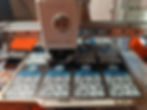The Benefits and Uses of FDM 3D Printing
- 3Define
- Nov 3, 2024
- 4 min read
Updated: Dec 22, 2024
FDM (Fused Deposition Modeling) is one of the most accessible and widely used 3D printing methods. Known for its affordability and versatility, FDM 3D printing brings a wide range of projects to life, from functional prototypes to custom parts. In this blog, we’ll cover the basics of FDM 3D printing, its advantages, material options, typical applications, and why it’s a go-to choice for many creators and industries.
What Is FDM 3D Printing?
FDM 3D printing is a process that involves melting thermoplastic filament and extruding it through a heated nozzle to build an object layer by layer. Each layer is deposited on top of the previous one, allowing complex shapes to be constructed. Compared to resin 3D printing, which uses liquid resin and UV light to cure layers, FDM is ideal for creating strong, durable parts without the need for extensive post-processing.
Key Benefits of FDM 3D Printing
Cost-EffectiveFDM is generally more affordable than other 3D printing methods, making it an excellent choice for businesses and individuals on a budget. The filament materials, such as PLA and ABS, are also relatively low-cost, allowing for economical prototyping and production of functional parts.
Strength and DurabilityFDM prints are known for their strength, especially when using durable filaments like ABS, PETG, or nylon. This makes FDM a reliable choice for producing functional parts that can withstand stress, temperature changes, and repeated use, making it perfect for applications like tooling, mechanical components, and end-use parts.
Wide Range of MaterialsFDM supports a variety of thermoplastic filaments, each with different properties:
PLA (Polylactic Acid): Eco-friendly, easy to print, and ideal for prototypes.
ABS (Acrylonitrile Butadiene Styrene): Strong, impact-resistant, and suitable for functional parts.
PETG (Polyethylene Terephthalate Glycol): Durable, flexible, and chemical-resistant.
Nylon: Highly durable and abrasion-resistant, ideal for mechanical parts.
Flexible Filaments (TPU/TPE): For parts that need flexibility, like gaskets or grips.
This range allows FDM to meet the demands of various projects, from decorative models to heavy-duty parts.
Speed and AccessibilityFDM printers are relatively easy to use, and the process is faster for larger parts compared to other methods. The straightforward setup and maintenance make it a practical choice for businesses and hobbyists alike. With the rapid prototyping capabilities of FDM, users can quickly test and iterate their designs without significant delays.
Customizable SettingsFDM printers offer a variety of adjustable settings like layer height, print speed, and infill density. These settings allow users to customize their prints according to specific requirements, balancing quality, speed, and strength. Lower layer heights, for example, can produce smoother surfaces, while higher infill percentages increase the strength of the printed part.
Popular Applications of FDM 3D Printing
Thanks to its versatility and strength, FDM 3D printing is widely used across different industries and applications:
Prototyping and Product Development: FDM is ideal for rapid prototyping, allowing designers and engineers to test concepts quickly and at a low cost. Prototypes made with FDM can undergo functional testing, helping teams refine designs before full-scale production.
Manufacturing and Tooling: FDM can produce custom tools, jigs, and fixtures, optimizing manufacturing processes and reducing costs. Durable filaments like ABS and PETG make FDM prints reliable for repeated use in industrial settings.
Consumer Products: FDM enables the production of customized items such as phone cases, organizers, custom car and machine parts, and kitchen tools, giving creators the ability to make functional products that are both affordable and personalized.
Educational Models and DIY Projects: FDM printing is a popular choice in educational settings due to its accessibility and low cost. Students can create models for engineering, science, and art projects, while DIY enthusiasts enjoy the freedom to create custom parts and inventions.
End-Use Parts: With the strength of materials like PETG and nylon, FDM can produce final products such as replacement parts, brackets, and casings that withstand everyday use.
Expertise Required for FDM 3D Printing
Although FDM 3D printing is considered more user-friendly than some other 3D printing technologies, achieving optimal results does require familiarity with printer settings and materials. Successful FDM printing often involves:
Choosing the Right Material: Selecting the appropriate filament based on the part’s intended use.
Calibration and Maintenance: Regular calibration of the printer bed and nozzle is necessary to ensure print accuracy and quality.
Post-Processing: While FDM typically requires less post-processing than resin printing, some prints may still benefit from sanding, priming, or painting for a finished look.
Working with an experienced FDM 3D printing provider can be beneficial, especially for projects that demand specific material properties or complex designs.
Why Choose FDM 3D Printing?
FDM 3D printing offers an ideal balance of affordability, strength, and accessibility, making it a popular choice for both professionals and hobbyists. From rapid prototyping to creating end-use parts, FDM’s wide range of materials and easy-to-use technology make it one of the most versatile 3D printing methods available. Whether you’re looking to develop a functional prototype, produce custom tools, or bring a creative idea to life, FDM provides a practical, reliable solution for a broad spectrum of applications.
Ready to explore the benefits of FDM 3D printing for your next project? Get in touch to see how our expertise and range of materials can bring your ideas to life with quality and precision.
